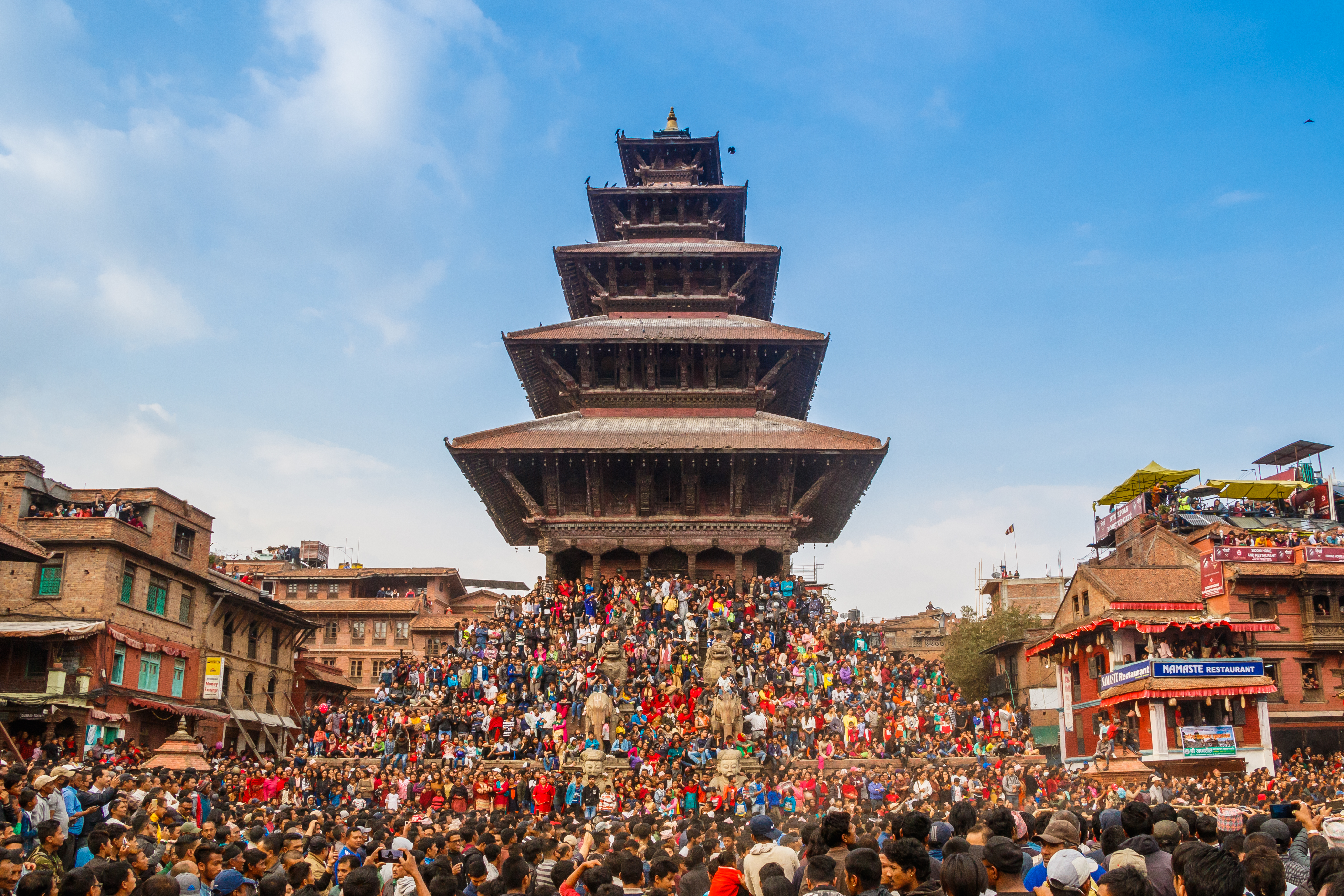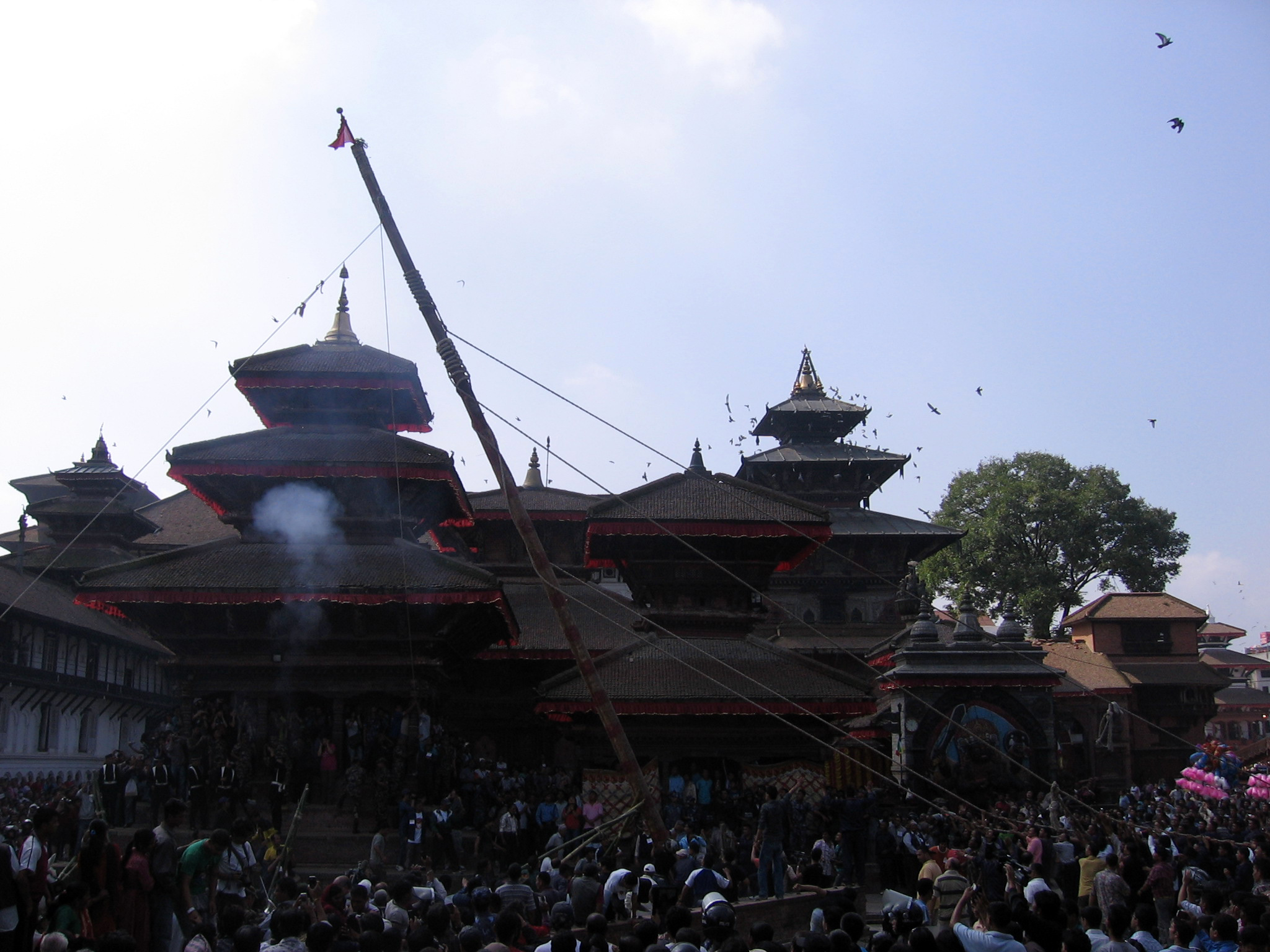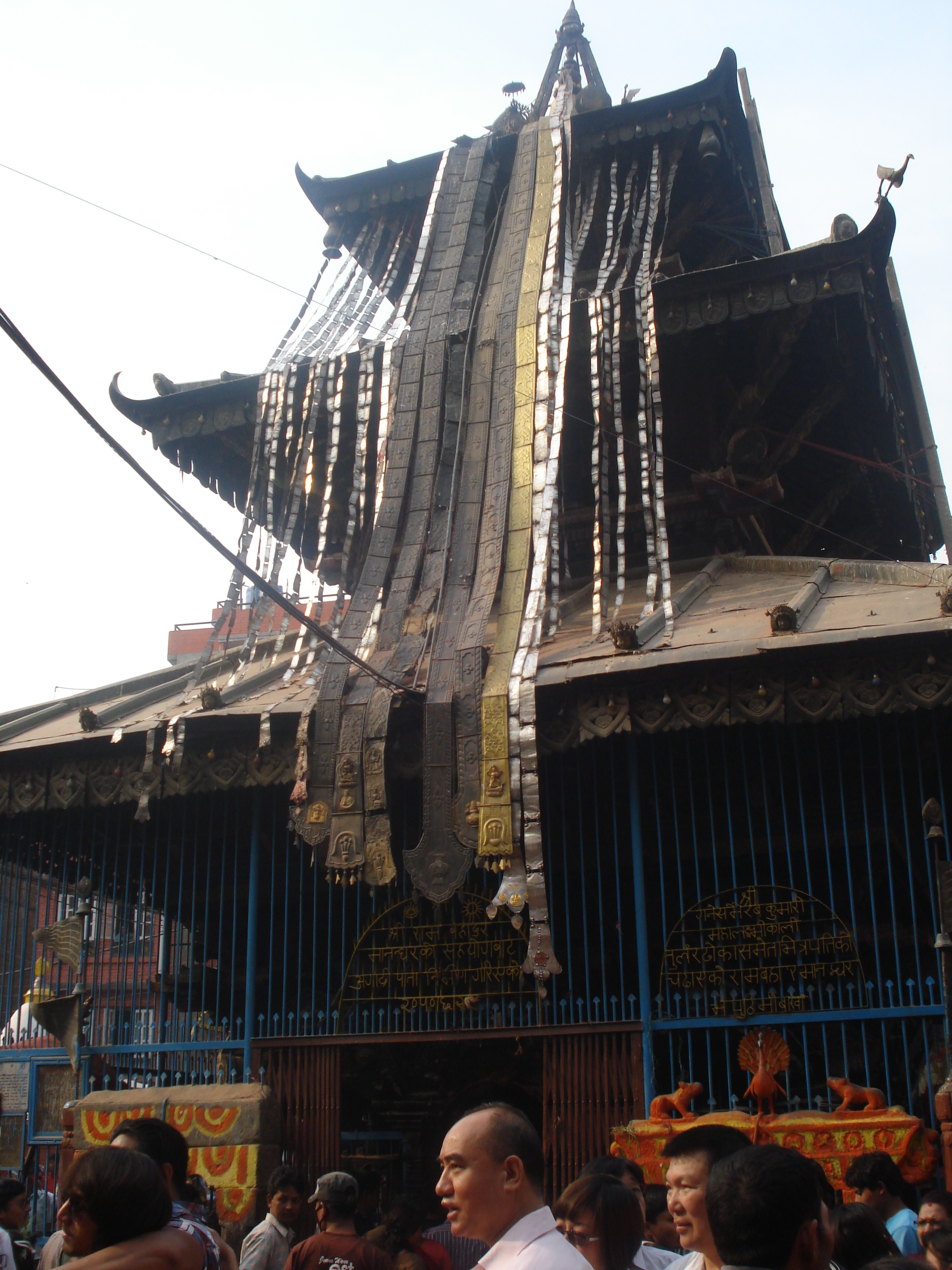|
Bisket Jatra
Biska Jatra, is an annual event in Bhaktapur, Dhapasi, Madhyapur Thimi and Tokha and other places in Nepal. The festival is celebrated at the start of the new year on the Bikram Sambat calendar, however, the festival itself is not related to Bikram Sambat. Origin Legend has it that this celebration is the "festival after the death of the serpent". Various areas of Bhaktapur city celebrate this festival according to their own rituals. The most eventful places are Taumadhi Square and Thimi Balkumari. A chariot carrying the statue of Lord Bhairava is pulled by hundreds of people to towards upper (''Thaney'') and lower (''Koney'') neighbourhood as tug of war. Approximately a month earlier, the chariot is assembled near the Nyatapola temple. Observations The signature event on Bhaktapur Taumadhi kicks off the Biska jatra "dya koha bijyaigu" which means the god Bhairava is brought outside from its temple for the festival, it is a tug-of-war between the Thane (upper) and Kone (lower ... [...More Info...] [...Related Items...] OR: [Wikipedia] [Google] [Baidu] |
Bhaktapur District
Bhaktapur district ( ne, भक्तपुर जिल्ला; Nepal Bhasa : ख्वप देश (जिल्ला) located in the eastern part of Kathmandu valley, is the smallest district among the seventy-seven districts of Nepal. It is part of Bagmati Province. The district, with Bhaktapur as its district headquarters, covers an area of and in 2011 had a population of 304,651 of whom 9,701 people were absent (mostly working abroad). Education The average literacy rate of Bhaktapur is 81.68, where male – 90.48 and female – 72.65 which is growing with the educational awareness among peoples. The governmental schools in Bhaktapur are making remarkable improvement in its educational quality. The government schools have been starting to facilitate students by teaching in both English and Nepali medium. Private schools too, such as CVM Secondary School, are well known for providing quality education. Despite topping other districts in SLC with highest enrolm ... [...More Info...] [...Related Items...] OR: [Wikipedia] [Google] [Baidu] |
Sindoor
Sindooram is a traditional vermilion red or orange-red coloured cosmetic powder from the Indian subcontinent, usually worn by married women along the part of their hairline. In Hindu communities the sindoor is a visual marker of marital status of a woman and ceasing to wear it usually implies widowhood. The main component of traditional sindooram is usually cinnabar (cinnabar is mercury sulfide, a toxic mineral), turmeric and lime. Some commercial sindoor products contain synthetic ingredients, some of which are not manufactured to proper standards and may contain lead. Application of sindoor Sindoor is traditionally applied at the beginning or completely along the parting-line of a woman’s hair (also called ''mang'' in Hindi or ''simandarekha'' in Sanskrit) or as a dot on the forehead. Sindoor is the mark of a married woman in Hinduism. Single women wear the bindi in different colours for special occasions but don't apply sindoor in their parting of the hairline. Widow ... [...More Info...] [...Related Items...] OR: [Wikipedia] [Google] [Baidu] |
Hindu Festivals In Nepal
Hindus (; ) are people who religiously adhere to Hinduism. Jeffery D. Long (2007), A Vision for Hinduism, IB Tauris, , pages 35–37 Historically, the term has also been used as a geographical, cultural, and later religious identifier for people living in the Indian subcontinent. The term ''"Hindu"'' traces back to Old Persian which derived these names from the Sanskrit name ''Sindhu'' (सिन्धु ), referring to the river Indus. The Greek cognates of the same terms are "''Indus''" (for the river) and "''India''" (for the land of the river). The term "''Hindu''" also implied a geographic, ethnic or cultural identifier for people living in the Indian subcontinent around or beyond the Sindhu (Indus) River. By the 16th century CE, the term began to refer to residents of the subcontinent who were not Turkic or Muslims. Hindoo is an archaic spelling variant, whose use today is considered derogatory. The historical development of Hindu self-identity within the local I ... [...More Info...] [...Related Items...] OR: [Wikipedia] [Google] [Baidu] |
Vaisakhi
Vaisakhi ( Punjabi: ), also pronounced Baisakhi, marks the first day of the month of Vaisakh and is traditionally celebrated annually on 13 April and sometimes 14 April as a celebration of spring harvest primarily in Northern India. Further, other Indian cultures and diaspora celebrate this festival too. Whilst it is culturally significant as a festival of harvest, in many parts of India, Vaisakhi is also the date for the Indian Solar New Year. For Sikhs, in addition to its significance as the harvest festival, during which Sikhs hold kirtans, visit local Gurdwaras, community fairs, hold ''nagar kirtan'' processions, raise the Nishan Sahib flag, and gather to socialize and share festive foods, Vaisakhi observes major events in the history of Sikhism and the Indian subcontinent that happened in the Punjab region. Vaisakhi as a major Sikh festival marks the birth of the Khalsa order by Guru Gobind Singh, the tenth Guru of Sikhism, on 13 April 1699. Later, Ranjit Singh was pro ... [...More Info...] [...Related Items...] OR: [Wikipedia] [Google] [Baidu] |
Indra Jatra
Indra Jātrā, also known as Yenyā (Nepal Bhasa: येँयाः), is the biggest religious street festival in Kathmandu, Nepal. The celebrations consist of two events, Indra Jātrā and Kumāri Jātrā. Indra Jātrā is marked by masked dances of deities and demons, displays of sacred images and tableaus in honor of the deity Indra, the king of heaven. Kumāri Jātrā is the chariot procession of the living goddess Kumari. Family members deceased in the past year are also remembered during the festival. The main venue of the festivities is Kathmandu Durbar Square. The celebrations last for eight days from the 12th day of the bright fortnight to the 4th day of the dark fortnight of Yanlā (ञला), the eleventh month in the lunar Nepal Era calendar. Indra Jatra was started by King Gunakamadeva- (गुणकामदेव) to commemorate the founding of the Kathmandu city in the 10th century. Kumari Jatra began in the mid-18th century. The celebrations are held accord ... [...More Info...] [...Related Items...] OR: [Wikipedia] [Google] [Baidu] |
Gai Jatra
Gai Jatra (), also known by its endonym Sa Paru (Nepal Bhasa: ), is a Nepalese festival celebrated mainly in the Kathmandu valley by the Newar people. The festival is celebrated in honour of their immediate relatives who have died during the previous year. Various groups of children dressed up as cows and in other comedic drags are organized throughout various cities. It is generally celebrated in the month of Bhadra (August/September). The date is set according to the lunar Nepal Samabat calendar and falls on the first day of the dark fortnight of the month of Gunla. Origin Gai Jatra was started by King Pratap Malla during his reign from 1641 to 1671 AD. His teenage son Chakravartendra Malla died an untimely death and the queen grieved the loss of her son. King Pratap Malla started this tradition to both help ascend his son to the next life and also to cheer the grieving queen and families of those whose loved ones had passed away. Etymology The festival is known as Sa ... [...More Info...] [...Related Items...] OR: [Wikipedia] [Google] [Baidu] |
Bode, Nepal
Bode is an ancient Newar city in the east corner of the Kathmandu Valley, Nepal, about eight miles from the capital city, Kathmandu.The city is famous for Biska Jatra and tongue piercing and Nilbharahi Naach. At the time of the 2011 Nepal census it had a population of 6,364 with 1,389 houses. Bode Planning, Bhaktapur, Nepal Bode Planning (area approximately 69 acres) is a small planned area located in the Bode, Bhaktapur of Nepal. Mostly the people from outer valley are living here. The office of "Agriculture Training Center" is located in this place. Bode as Agriculture Most of the people in Bode work in agriculture, including horticulture and animal husbandry. Rice is the most common agricultural crop. Other crops are Maize Maize ( ; ''Zea mays'' subsp. ''mays'', from es, maíz after tnq, mahiz), also known as corn (North American and Australian English), is a cereal grain first domesticated by indigenous peoples in southern Mexico about 10,000 years ago. The ... ... [...More Info...] [...Related Items...] OR: [Wikipedia] [Google] [Baidu] |
Dhimay
Dhimay, Dhimaya ( new, धिमय्) or Dhime is a traditional Nepalese drum of the Newar people. According to the Hornbostel–Sachs classification, it belongs to the category of double-headed cylindrical membranophone A membranophone is any musical instrument which produces sound primarily by way of a vibrating stretched membrane. It is one of the four main divisions of instruments in the original Hornbostel-Sachs scheme of musical instrument classification. .... Description The drum is rather big compared to other drums played by the Newars in Nepal. The size of this instrument varies from diameter of 40 inches to 51 inches and length of 17 inches to 21 inches. The shell of the drum is made of wood or metal. Sometimes wooden drums are partly covered with metal foil. The shape of old Dhimay drums is mostly irregular, formed by the natural shape of the piece of wood being used to make the drum body. Modern drums are either cylindrical or slightly barre ... [...More Info...] [...Related Items...] OR: [Wikipedia] [Google] [Baidu] |
Madhyapur Thimi
Madhyapur Thimi, also known as Thimi, ( ne, मध्यपुर थिमि) is a municipality in Bhaktapur District in the Bagmati Zone of central Nepal. Thimi lies between Kathmandu, Lalitpur and Bhaktapur in the Kathmandu Valley. It is one of the ancient cultural and historical places along the trade route from Bhaktapur to Kathmandu. The city is situated on elevated land and occupies an area of , divided into nine administrative wards. The mayor was Madan Sundar Shrestha of the Communist Party of Nepal (Unified Marxist–Leninist) of Nepal. Archaeology There are indications that the city may be as old as 3000 BC. A recent work by Mohan Pant and Shuji Funo compared the very regular grid layout of Thimi to other ancient cities in the Indus valley and Nepal. The details of the grid dimensions of city blocks are very close to those of Mohenjo-daro and Sirkap (part of ruins near Taxila) in Pakistan; also Patan, Nepal. The authors found that plot dimensions measure by , and are ... [...More Info...] [...Related Items...] OR: [Wikipedia] [Google] [Baidu] |
Nepal
Nepal (; ne, :ne:नेपाल, नेपाल ), formerly the Federal Democratic Republic of Nepal ( ne, सङ्घीय लोकतान्त्रिक गणतन्त्र नेपाल ), is a landlocked country in South Asia. It is mainly situated in the Himalayas, but also includes parts of the Indo-Gangetic Plain, bordering the Tibet Autonomous Region of China China–Nepal border, to the north, and India India–Nepal border, in the south, east, and west, while it is narrowly separated from Bangladesh by the Siliguri Corridor, and from Bhutan by the States and union territories of India, Indian state of Sikkim. Nepal has a Geography of Nepal, diverse geography, including Terai, fertile plains, subalpine forested hills, and eight of the world's ten List of highest mountains#List, tallest mountains, including Mount Everest, the highest point on Earth. Nepal is a multi-ethnic, multi-lingual, multi-religious and multi-cultural state, with Nepali langua ... [...More Info...] [...Related Items...] OR: [Wikipedia] [Google] [Baidu] |
Bisket Jatra Festival 2018 At The Nyatapola Temple, Bhaktapur
A biscuit is a flour-based baked and shaped food product. In most countries biscuits are typically hard, flat, and unleavened. They are usually sweet and may be made with sugar, chocolate, icing, jam, ginger, or cinnamon. They can also be savoury, similar to crackers. Types of biscuit include sandwich biscuits, digestive biscuits, ginger biscuits, shortbread biscuits, chocolate chip cookies, chocolate-coated marshmallow treats, Anzac biscuits, ''biscotti'', and ''speculaas''. In most of North America, nearly all hard sweet biscuits are called "cookies", while the term "biscuit" is used for a soft, leavened quick bread similar to a less sweet version of a ''scone''. "Biscuit" may also refer to hard flour-based baked animal feed, as with dog biscuit. Variations in meaning * In most of the world outside North America, a biscuit is a small baked product that would be called either a "cookie" or a "cracker" in the United States and sometimes in Canada. Biscuits in the Unite ... [...More Info...] [...Related Items...] OR: [Wikipedia] [Google] [Baidu] |
Nyatapola
Nyātāpola (Nepal Bhasa: , "''ṅātāpola''", ) is a five tiered temple located in the central part of Bhaktapur, Nepal. It is the tallest monument within the city and is also the tallest temple of Nepal. This temple was commissioned by King Bhupatindra Malla, the construction of which lasted for six months from 31 December 1701 to 15 July 1702. The temple has survived four major earthquakes and its aftershocks including the recent 7.8 magnitude April 2015 earthquake which caused major damage the city of Bhaktapur. The Nyatapola is noted for its unique architecture as it is one of only two five storey temples in the Kathmandu Valley, the other one being the Kumbheshvara in Lalitpur and its five level plinth which along with steps to the top part also contains pairs of stone statues of animals and deities serving as the temple's guardians. Along with the Bhairava temple and other historical monuments, the Nyatapola forms the ''Tamārhi'' square, which forms the central an ... [...More Info...] [...Related Items...] OR: [Wikipedia] [Google] [Baidu] |


.jpg)






